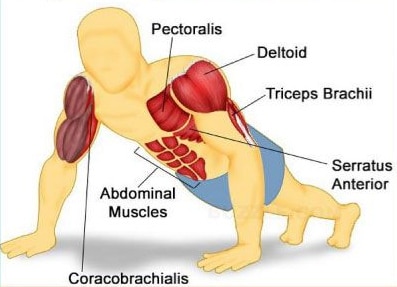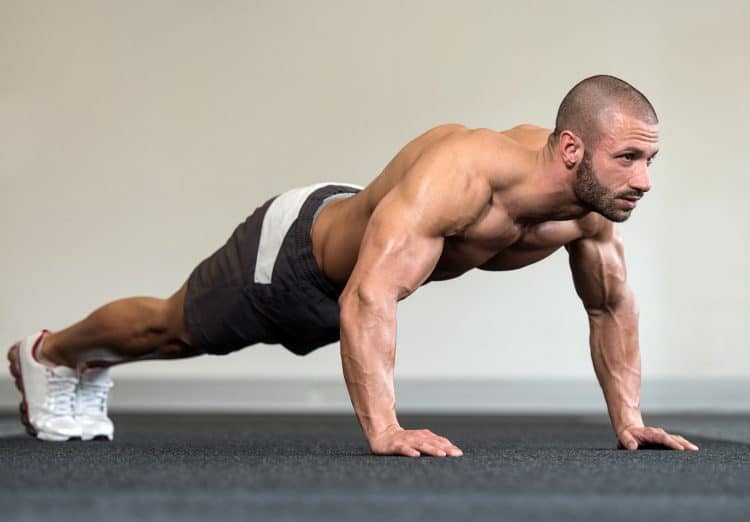Building muscle is often seen as complicated and time-consuming. According to a lot of training information, you need access to state-of-the-art workout equipment and have to spend many hours in the gym to build the body of your dreams.
However, this doesn’t have to be the case. In fact, you can build muscle and strength effectively and efficiently doing nothing but push-ups and pull-ups!
Between them, these exercises work all your major upper body muscles. And yet, they’re so straightforward and accessible that you can probably do them at home.
In this article, we’re going to refresh your push-up and pull-up knowledge and provide you with 11 tried-and-tested workouts for upper-body muscle gains.
Push-up 101

The push-up is the most widely performed exercise on the planet. From school kids in PE class to Olympic athletes and folk in the military, the push-up is a workout staple. And yet, a lot of lifters soon give up push-ups in favor of bench presses and other “more advanced” resistance training exercises.
The thing is, your muscles can’t really tell the difference between doing push-ups on a dusty floor and using a $20,000 chest press machine. They just know work and tension. Providing you train hard enough, even the humble push-up can make you stronger and more muscular.
Level Up Your Fitness: Join our 💪 strong community in Fitness Volt Newsletter. Get daily inspiration, expert-backed workouts, nutrition tips, the latest in strength sports, and the support you need to reach your goals. Subscribe for free!
Push-up anatomy

The push-up is a classic compound exercise. That means it involves several muscles and joints working together, which makes it a very functional and time-efficient movement.
The main muscles involved in push-ups are:
- Pectoralis major – pecs for short and basically your chest
- Anterior deltoids – the muscles at the front of your shoulders
- Triceps – the muscles at the back of your upper arms
- Rectus abdominis – the muscles on the front of your abdomen
- Serratus anterior – the “sawtooth” muscles on the side of your chest
Push-ups, performed correctly, even involve your quadriceps, which are the muscles on the front of your thighs. However, the load on your quads is pretty low, so you probably won’t feel them working particularly hard.
How to perform push-ups
The push-up might be the most popular exercise on the planet, but it’s also one the most poorly performed. Get more from your push-up workouts by doing them the right way.
- Squat down and place your hands flat on the floor. Your fingers should point forward, and your hands should be slightly wider than shoulder-width apart.
- With your arms straight, walk your feet out and back, so your shoulders, hips, and feet form a line. Brace your abs and pull your shoulders down and back. Tuck your chin in and lengthen your neck.
- Without breaking alignment, bend your elbows and lower your chest down to within an inch of the floor. Tuck your elbows into your sides as you descend.
- Drive your hands into the floor, extend your arms, and push your chest away from the floor. Straighten but do not lock your elbows at the top of each rep.
- Descend and repeat!
Push-up variations
The basic push-up is an excellent exercise. However, as you get stronger, you may need to progress to a more demanding variation to make your workouts more challenging. There are also push-up variations that let you emphasize different muscle groups.
Feel free to use different types of push-ups in any of the workouts featured in this article.
Popular push-up variations include:
- Kneeling push-ups
- Feet-elevated push-ups (aka decline push-ups)
- Deficit push-ups
- Ring push-ups
- Diamond push-ups (aka close grip push-ups)
- Plyo push-ups
- Pike push-ups
- Handstand push-ups
You can read more about different types of push-ups in the detailed guide.
Pull-up 101

The pull-up is the perfect partner for push-ups. It’s equally low-tech but high-effect. And, like the push-up, you don’t need a lot of fancy equipment to do this awesome exercise. However, the pull-up IS more challenging, so most people can only do half as many reps as they can for push-ups. Get around this by using a 2:1 ratio of push-ups to pull-ups.
The other downside to pull-ups is that you’ll need somewhere to hang from to do them. Good options include:
- Doorway pull-up bars
- Freestanding pull-up bars (aka power towers)
- Tree branches
- Gymnastic rings
- Ceiling joists
- Playground climbing frames
So, while pull-ups aren’t always as convenient to perform as push-ups, you should still be able to find or create somewhere to do them.
Pull-up anatomy
Just like push-ups, pull-ups are a compound upper body exercise that trains several important muscle groups simultaneously. The main muscles trained during pull-ups are:

- Latissimus dorsi – lats for short and located on the side of your upper back
- Trapezius – traps for short and the muscles of the upper back
- Posterior deltoids – the muscles on the back of your shoulders
- Biceps – the muscles on the front of your upper arms
- Core – the muscles of your midsection
How to perform pull-ups
There are two basic forms of the pull-up – overhand and underhand grip. Underhand grip pull-ups are often called chin-ups, making it easier to know which exercise is which. Pull-ups and chin-ups work all of the same muscles and are largely interchangeable. In most cases, it doesn’t matter much which one you do, provided you do them correctly.
- Grip your overhead bar with an overhand, slightly wider-than-shoulder-width grip (pull-ups) or a narrower-than-shoulder-width underhand grip (chin-ups).
- Hang with your arms straight and your feet clear of the floor.
- Pull your shoulders down and back, and brace your core.
- Without swinging your body or kicking your legs, bend your arms and pull your chin up and over the bar. Do not crane your neck. Drive your elbows down and back and think about leading with your chest.
- Lower yourself down smoothly and under control, and then repeat.
Pull-up variations
The basic pull-up and chin-up are excellent exercises, but you can have too much of a good thing. The good news is that there are some variations you can use to make your workouts challenging and effective.
Feel free to use different types of pull-ups in any of the workouts featured in this article.
Popular pull-up variations include:
- Australian pull-ups (aka inverted pull-ups)
- Narrow grip pull-ups and chin-ups
- Wide grip pull-ups and chin-ups
- Weighted pull-ups and chin-ups
- Band-assisted pull-ups and chin-ups
- Chest-to-bar pull-ups and chin-ups
- Commando pull-ups
- Towel grip pull-ups
Read more about the different pull-ups and chin-ups you can do in this in-depth guide.
11 Push-Up/Pull-Up Workouts for Upper Body Muscle Gains
Now we’ve refreshed your push-up and pull-up knowledge, here are 11 push-up/pull-up workouts for upper-body muscle gains. Do them instead of your usual gym workout, when traveling, or just because you prefer training at home or the park!
1. 3-minute density blocks
The premise of this workout is simple, but the execution is far from easy! Set your countdown timer for three minutes and do as many push-ups as you can in that time. Take breaks when you need to but clock up as many reps as possible. Make a note of your score.
Next, rest a minute, and do the same for pull-ups or chin-ups. Again, crank out as many reps as possible, taking breaks as required. Make a note of your score.
Do your best to do more reps than last time when you repeat this workout.
2. Ladder sets workout
Ladder sets get harder as your workout progresses, but then, just as you hit failure, they get easier so you can build up the intensity again.

To do this workout, do one pull-up followed by two push-ups. Take a quick breath, and then do two pull-ups and four push-ups. Take another breath or two, and then pump out three pull-ups and six push-ups.
Continue in this fashion until you cannot complete the next rung of the ladder.
Decrease the reps back to one pull-up and two push-ups and start over. Build up again until you reach failure and then return to one pull-up and two push-ups and repeat one more time.
As you get more and more tired, you may find you can’t climb so high on each subsequent ladder, so your workout may end up looking something like this:
- 1st ladder – Pull-ups: 1/2/3/4/5/6 Push-ups: 2/4/6/8/10/12
- 2nd ladder – Pull-ups: 1/2/3/4/5 Push-ups: 2/4/6/8/10
- 3rd ladder – 1/2/3/4 Push-ups: 2/4/6/8
3. Straight sets to failure
This workout might be straightforward, but it’s still an effective way to build muscle and get stronger. Simply do three, four, or five sets of pull-ups and push-ups to failure. Rest 3-5 minutes between sets so you can do the maximum number of reps.
The best way to do this workout is as a lazy superset. So, do your first set of pull-ups, rest for about two minutes, and then do your first set of pull-ups. This will give you the required amount of rest but makes better use of your time.
4. Pyramids
Pyramids are similar to ladders, but after working your way up to a peak, you then come back down instead of starting back at the bottom.
Level Up Your Fitness: Join our 💪 strong community in Fitness Volt Newsletter. Get daily inspiration, expert-backed workouts, nutrition tips, the latest in strength sports, and the support you need to reach your goals. Subscribe for free!
For example:
- 1st pyramid – Pull-ups: 1/2/3/4/5/4/3/2/1 Push-ups: 2/4/6/8/10/8/6/4/2
As with ladders, you may find that you are unable to hit the same peak as the workout progresses. For example:
- 2nd pyramid – Pull-ups: 1/2/3/4/3/2/1 Push-ups: 2/4/6/8/6/4/2
- 3rd pyramid – Pull-ups: 1/2/3/2/1 Push-ups: 2/4/6/4/2
5. 50% sets
With this workout, you do sets of pull-ups and push-ups, taking each one to failure until you cannot do 50% of the number of reps in your first set. Rest exactly 60 seconds between sets.
For example:
- 1st set pull-ups – 12 reps
- 2nd set pull-ups – 10 reps
- 3rd set pull-ups – 8 reps
- 4th set pull-ups – 7 reps
- 5th set pull-ups 5 reps (less than 50% of the first set, so that’s the end)
Rest a moment and then repeat with push-ups.

6. Red card, black card
This workout assigns random numbers of reps to your pull-ups and push-ups. Sometimes you’ll do high reps, and other times it’ll be low. It all depends on the luck of the cards! However, by the end if your workout, you’ll accumulate a lot of muscle-building reps.
Grab a deck of cards, and remove one red suit, e.g., hearts, and one black suit, e.g., spades. Discard the jokers, too. Shuffle the remaining cards together and then place them face down.
Turn over the top card. If it’s red, you’re doing push-ups, and if it’s black, you’re doing pull-ups.
For pull-ups, do the number of reps indicated by the card’s value. So, if you turn up a seven, you do seven reps. Allocate 11 to jacks, 12 to queens, and 13 to kings. Aces are worth one.
But, because push-ups are easier than pull-ups, if you turn up a red card, you need to do double the number shown. So, a five means ten push-ups, and a king means 26.
Work through the pack until each card has been turned over and completed. You’ll probably get runs of the same color and several high cards in a row. When that happens, rest as necessary, but do not turn over the next card until you’ve done all the required reps.
7. Race to 50 pull-ups and 100 push-ups
This workout is a real “no-brainer” but no less effective because of it. Simply do 50 pull-ups in as few sets as possible. Rest when you need to, but keep cranking out the reps, even if it’s just a couple at a time.
Catch your breath for a moment and then do the same with push-ups, but this time, you must complete 100 reps in as few sets as you can.
Your goal is to complete the entire workout in under ten minutes.

8. Escalating density training
Escalating density training, known as EDT for short, is a workout method invented by strength coach Charles Staley. Instead of prescribing a specific number of sets and reps, your job is to do as many reps as possible in a predetermined time frame, called a PR zone.
Exercises are performed in pairs, which makes EDT perfect for push-ups and pull-ups.
So, for this workout, set your timer for 15 minutes. Then, simply do a set of push-ups immediately followed by a set of pull-ups. Go back and forth between the two exercises until the clock runs out.
Don’t take your first few sets to failure, as doing so will reduce the total number of reps you can perform. Instead, do around 50-60% of your maximum number of reps to keep fatigue at bay and maximize the number of sets performed in the 15-minute PR zone.
9. Iso-dyno pull-up and push-up workout
This workout takes two minutes but don’t let that brevity fool you – this is going to be tough! It combines isometric training with dynamic reps to fatigue your muscles quickly and efficiently.
Starting with the pull-ups, do reps for 15 seconds and then pause with your chin over the bar and hold it there for 15 seconds. Next, do reps for ten seconds and then pause with your chin over the bar for ten seconds. Finally, do five seconds of reps and a five-second hold. If this is too challenging for pull-ups, use the same sequence with inverted rows instead.
Rest a moment and then move onto push-ups. Do reps for 15 seconds, then pause with your chest an inch above the floor for 15 seconds. Rep out for ten seconds and then pause with your chest an inch above the floor for ten seconds. Finally, do reps for five seconds and pause for five seconds.
This is an excellent finisher after a more conventional strength training workout.

10. 60-second pull-up and push-up
Like workout #9, this workout also takes two minutes, but it’s going to be intense!
Hang from your pull-up bar, making sure you can see a clock. Take 30 seconds to slowly pull your chin up to the bar and another 30 seconds to slowly come back down. No pausing allowed – you must keep moving throughout the allotted time, albeit very slowly.
Rest a moment and then repeat with push-ups. Start with your arms bent and, taking 30 seconds, slowly extend your arms and push yourself up. Then, without pausing, take 30 seconds to return to the starting position.
If 60 seconds is too long, feel free to do 50, 40, or 30 seconds instead. Increase the time as you get used to the exercise.
11. Tabata pull-ups and push-ups
While the Tabata protocol was never designed for strength training exercises, it works pretty well for creating a lot of local muscular fatigue in a very short time. This entire workout takes no more than ten minutes, so it’s ideal for time-pressed exercisers.
Firstly, do 20 seconds of pull-ups, rest for ten seconds, and then repeat. Do eight sets. If you cannot crank out any more reps, just hang from the bar with your lats and arms flexed.
Rest a moment, and then do the same thing with push-ups.
Alternatively, you can alternate between pull-ups and pull-ups to give yourself more rest between exercises. Just do two Tabatas back-to-back to accumulate the same workout duration.
11 Push-Up/Pull-Up Workouts
Many exercisers are very quick to dismiss push-ups and pull-ups, labeling them as boring or too straightforward to be effective. And if you only do regular sets of these classic bodyweight exercises, that criticism could hold water.
However, there is no reason to use the same old set and rep scheme – there are lots of ways to make push-ups and pull-ups challenging and entertaining.
We’ve presented you with 11 different workouts, but by using pull-up and push-up variations, you can create many more. You could probably train every day for a month without repeating a workout.
So, no gym? No problem!
You can build an impressive upper body with nothing but pull-ups and push-ups. Use these workouts to train your chest, back, shoulders, and arms anywhere and anytime.








